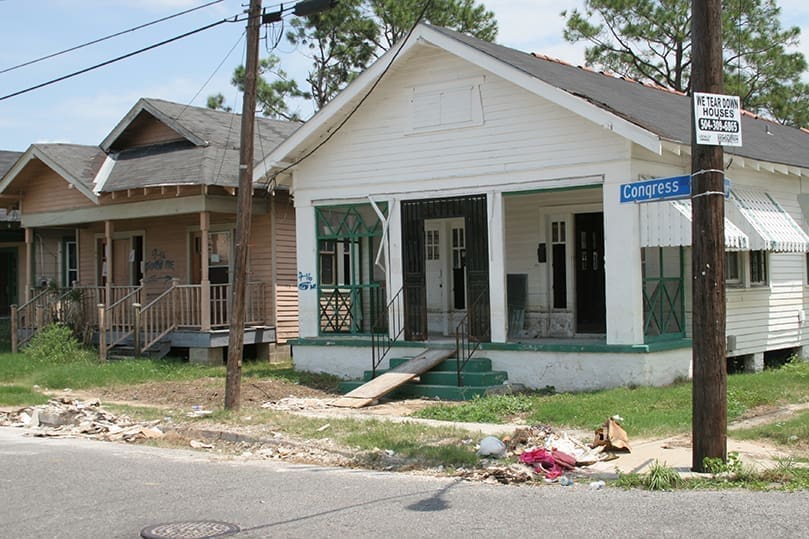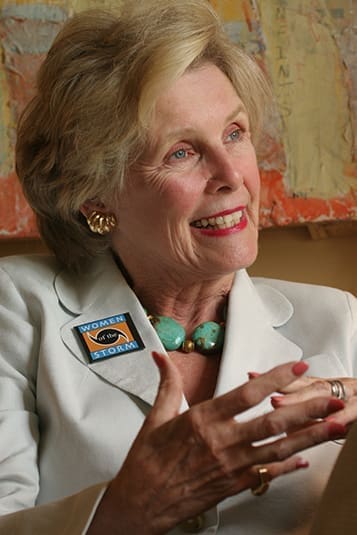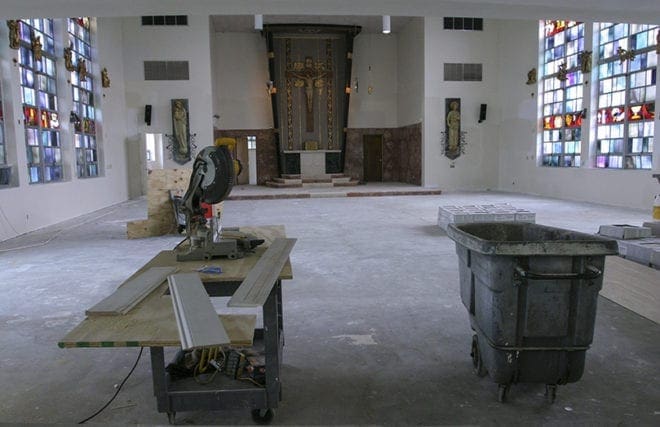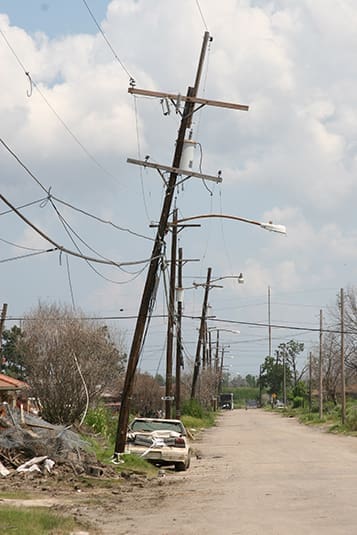 Photo by Michael Alexander
Photo by Michael AlexanderNew Orleans
‘Women Of The Storm’ To Blitz Washington Again
By PRISCILLA GREEAR, Staff Writer | Published September 14, 2006
Anne Milling answered with delight a call late one July afternoon from a businessman she had tried to reach unsuccessfully since May. Her perseverance paid off, as the caller donated $25,000 to help her and nearly 130 other civic-minded New Orleans women of diverse races, ages and religions to head to Washington, D.C., for the second time this year to educate members of Congress on the city’s recovery and regional coastal restoration needs.
She and other community activists in January rounded up the first group of some 130 women from all ethnic backgrounds, all with a passion to help the city and a “proven track record of service.”
Working with a Washington public relations firm and raising the money so no one would be unable to afford to go, they took a $70,000
5 a.m. charter flight, reviewed their talking points on the plane, and arrived in Washington armed with umbrellas made of blue tarp and their new name: Women of the Storm.
After jump-starting the day with a press conference, they set out two by two, each woman matched with someone she didn’t know, and met with a member of Congress or their staff. Politicians were formally invited to come to post-Katrina New Orleans, with financial assistance, if needed, and tour the devastation. Their guide would be a National Guard brigadier general or nonprofit group, with lodging provided by the Greater New Orleans Hotel and Lodging Association and presentations by the Louisiana Recovery Authority and the Governor’s Advisory Commission on Coastal Restoration and Conservation.
“It was a terribly exciting day,” Milling recalled, and so far some 55 senators and 100 representatives have found it an offer they couldn’t refuse.

New Orleans socialite Ann Milling is the leading advocate behind Louisiana’s Women of the Storm. Photo by Michael Alexander
And now the women are storming the capital again Sept. 20, targeting those who haven’t yet paid the city a visit, along with key members of Congress.
Milling’s love of the city where she was born and raised resonated as she answered the July 24 call from the donor, after taking three other calls in the hour.
“Hello? … I’m glad we’re connecting. I know you don’t want to talk to me, but that’s all right because whenever you talk to me, I need money. I need money for the Women of the Storm. Could you help us?” she amicably asked while naturally easing into fundraising mode. “… I did. I asked you for 25, and we’re trying to go back to Washington in September. I got it? Really, you sure it’s OK? Oh, it will help us so much, if you only knew. We’ve been taking care of these congressmen and running up a deficit … but I have faith that people like you will help, and I’m very grateful … I promise I won’t call you for the rest of the year unless I call you (so we can all) go have dinner!”
Milling, a Catholic who has chaired the board of trustees of Loyola University and has extensive volunteer experience, was ebullient as she contemplated the donation while rain showered against the large windows and on the pristine backyard of her elegant home.
“Boy, am I excited. … Like the little Sisters of the Poor, I just know God will provide. I just know,” she said. “My letter has been on this man’s desk since May 22, and I just knew that if I kept calling him, eventually he’d have to answer my phone call. I called him today and I thought, oh, please call me back. I must have called him four times.”
Blitzing the nation’s capital with women passionate about the region’s recovery is “an expensive deal, but it’s worth it,” she said, because it incites action and ensures their plight as a major port city remains in the forefront of national consciousness.
Wearing a Women of the Storm pin on her tailored white pants suit, she explained that the group’s focus is now more on the need to secure funding to restore the Louisiana coast and barrier islands, since in June Congress allocated almost an additional $12 billion to the state including $4.2 billion for post-Katrina housing and $3.7 billion to upgrade the levees.
Beyond levee fortification, Milling said, is the larger environmental issue of protecting the city that is nearly 80 percent below sea level, a longstanding problem exacerbated after Katrina.

Repairs are underway at the Sisters of the Holy Family Motherhouse and Noviate chapel, New Orleans. In addition to this property, all their buildings, which included a convent, an all girls high school, assisted living facilities, and a nursing home, sustained water damage across the entire first floor. Photo by Michael Alexander
Coastal Louisiana, one of the largest estuaries and seventh largest delta in the world, loses 24 square miles a year of its wetlands of marsh, barrier islands and shallow bays, and it serves to protect the coast by absorbing storm surges and diminishing the size and scope of hurricanes. According to Sen. Mary Landrieu’s office, the loss of these wetlands is caused largely by the construction along the Mississippi River of riprap or concrete mats, which keep ships moving and provide flood protection but deprive the river of millions of tons of soil. Also, jetties deposit remaining sediment deep into the Gulf, which deprives the coast of soil and contributed to the city falling below sea level. Furthermore, pipelines and canals through the marsh let salt water eat away at the land. The Commission estimates that restoring Louisiana’s coast will cost over $14 billion, but that the cost of inaction will amount to more than $100 billion to address the effects of costal deterioration on infrastructure alone. “The needs are tremendous for coastal restoration, needs for $14 billion. Without the coastal restoration all this other stuff is for naught. We have to have a coast and wetlands to absorb these storms as they come across Louisiana,” said Milling.
The idea of traveling to Washington, D.C., to awaken politicians to the devastation germinated as she and her husband King hosted a Thanksgiving gathering for several friends who had lost their homes in Katrina. Feeling blessed that their home was spared even as others down the street were flooded, she began to ask her friends their thoughts on it, and all thought it was great—for her to spearhead.
“I couldn’t get it off of my mind, and it haunted me after my family went back to their homes after Christmas. I thought it was very much like the Holy Spirit gnawing at me, saying you know you’ve got to do this, and so I thought of all the people I know who have energy and capabilities and a proven track record, and I asked a couple of men to come too,” she recalled.
She assembled a core group and held a meeting. “I said this may be the quickest meeting you’ve been to, and in 15 minutes you all may tell me to go jump in the lake. We sat around the table right there, and I said here’s my idea, and they all said we’ve got to run with it. It’s fabulous. It’s so basic and natural to extend an invitation to people who you want to come and see.”
They began networking to broaden their group of accomplished businesswomen and women volunteers who knew the issues intimately. Milling, for example, called a Vietnamese priest she knew and asked for some go-getters, while another worked her connections as a former roommate of the first lady.
On the trip, some met with elected officials while others met with their staffers, sharing the plight of their city. As CNN flashed reports of their visit on TV screens across Capitol Hill women began getting cell phone calls that more politicians would be happy to meet with them.
“We hand-delivered an invitation—not an 8.5 by 11 inch sheet of paper, but an invitation—‘Women of the Storm invite you to see the devastation,’ we really made it that way with an RSVP card and a book on America’s wetlands,” she continued. “When we left, only 10 senators had been here and to date (by late July) 52 have come, and I think that our consistency, our tenaciousness, our perseverance has truly made a difference. We continue to call these offices and we nag—we urge, we encourage, and we don’t give up in inviting them, and we try to make it as easy for these congressmen as possible.”
As of Sept. 10, 55 senators and 100 representatives have visited, and they’re eager to accompany more to see the grim sights, starting with many areas filled with abandoned houses with collapsed roofs and walls.

An abandoned car sits on Flood Street in the desolate Lower 9th Ward neighborhood of New Orleans amid leaning power line poles. Photo by Michael Alexander
“This is the biggest (natural) disaster that has ever happened in the history of our country, and we feel they need to come and see it and see where their dollars are going. If we have need for future dollars, they’ll understand what the problems are, where their dollars are going. Every visitor who has come has been stunned by the magnitude of the destruction. It’s block after block, mile after mile,” she said.
“The water works is decimated, our utilities are crumbling … our utility company is bankrupt, just drive around the city, our streets are deplorable.”
Last time Milling met with the staff of first lady Laura Bush “for a good hour” and this round her list of scheduled visits includes Sen. John McCain, who “said this was one of the best presentations he’d ever had” on his visit to Louisiana.
While she already knew U.S. senators and representatives from Louisiana, the savvy fundraiser had only previously visited the capital as a tourist with her husband and three sons. As far as being a Washington activist, “this was so foreign to us.”
“What was interesting is so many of them pay attention to the news and because of this press conference we were all over the news that day. Here we were, these Women of the Storm ladies, going all around carrying these blue tarp umbrellas, and they began to recognize us. It was really kind of amusing. In fact, when we got to Mrs. Bush’s office at the end of the day they all had seen us on CNN and all these news programs, and they said when we came in ‘we just love what you’ve done, how did you get such press?’”
About two-thirds of the participants this September will be second-timers, and the newcomers “were just dying to participate.” The issue of coastal restoration is timely, as both House bill 4761 and a similar Senate bill 3711 have been passed by their chambers and are expected to be negotiated to reach a compromise before the end of the month. The Senate bill, cosponsored by Mary Landrieu, D-La., calls for new Gulf of Mexico oil and gas drilling and for a percentage of royalties to go to Louisiana, Alabama, Mississippi and Texas to fund future coastal restoration and other hurricane protection.
“Our coast is vanishing and washing away, and … part of our protection for this city is to have the buffer of the wetlands. That absorbs storm surge, and it’s disappearing. … Oil and gas come right off the coast of Louisiana, and we’re asking the federal government to give us a portion of the revenue they receive from oil and gas,” said Milling.
She stressed the importance of this port city at the mouth of the Mississippi to the whole country. About 30 percent of all commercially sold fish comes through New Orleans’ docks; it produces or transports 30 percent of the nation’s domestic crude oil and 34 percent of its natural gas and also refines 16 percent of America’s petroleum. Milling’s husband King chairs the Coastal Restoration Commission on which he’s served since its formation in 2002.

Nearly a year later some neighborhoods in New Orleans’ St. Bernard Parish are like virtual ghost towns where abandoned commercial and residential property remains a vivid reminder of the devastation Hurricane Katrina left behind. Photo by Michael Alexander
He praised all the women’s efforts that allow commissioners to then educate visiting politicians.
“They’re doing a fantastic job … They have helped to highlight the issues and will so do in the future. These are issues the country needs to face. We’re dealing with a difficult time frame in which to do it, but the president has indicated the recovery of the coastal area is critical,” he said in a phone interview.
He explained that levees will have to be rebuilt continually in more complex ways without the restoration of the ecosystem. Restoring the ecosystem involves restoring the protective barrier islands, reintroducing the natural resources of the Mississippi River in a very controlled fashion back into the ecosystem to reestablish the ecosystem’s life cycle and introducing system beneficial dredged material.
“This is a national problem in that its cause is primarily federal policies, and this area provides natural resources that allow this country to function,” he said. “It’s a gigantic environmental issue that overshadows all these other commercial and personal issues. It’s an issue of urgency down here because there is big loss every year, and if (the government) doesn’t do something like this, this system will be lost, and it will be too late.”
Sen. Landrieu, whose mother Verna Landrieu is making her second trip, is also grateful indeed that the women are advocating for Gulf Coast revenue sharing for oil and gas drilling to provide a reliable source of continual funding for coastal restoration. “It’s a life- and-death situation for Louisiana, life for our community as well as individual lives.”
She called Women of the Storm a “very powerful force and critical group” to help get the Louisiana coalition’s message across and believes they will “really make a difference for the long-term stability and rebuilding of the city and region.” After all, “lots of organization come to Washington but not everyone walks up and down the streets holding a blue umbrella.”
“I’m happy for the help. They’ve been a great addition to the delegation’s efforts. They’ve issued a national challenge. I’m encouraged that 56, more than the majority, have come down so far” to walk through devastated neighborhoods.
She also appreciates how these strong, resourceful women have taken other community leaders of various professions who are in town from around the country on the tour, and these leaders continue to spread the word back home.
“There are women like this in every community who built the schools, churches, hospitals and basically hold the community together, not a Democrat or Republican group, a community group. And every community in America has women like this, the heart and soul of the community,” she said. After Katrina “they decided to do something about it and (saw) a bake sale ain’t gonna cut it. They decided they better go to where the power and money are and let the destruction be seen firsthand.”
Her mother Verna Landrieu, wife of Moon Landrieu, who was mayor of New Orleans for eight years, gladly joined the cause and the ranks of this “impressive group of women.” Three of her nine children’s homes had extensive flooding, and she just got her electricity back in February and a land phone line in September.
“We’re not an isolated area but a very vital part of the country,” she said. “You have to keep them aware (in Washington). There’s so much else going on in the country and with the war. It’s a gargantuan problem but worth the investment because of what this area provides for the country (in) oil and gas.”

A drive along the harbor through the West End neighborhood of New Orleans as late as July reveals the boats and yachts that still remain tossed over on their sides. Photo by Michael Alexander
Mrs. Landrieu said people remain “very apprehensive” about the levees and reflected on the slow recovery process and her concern for the local economy. Many businesses in her neighborhood remain closed and allocated money seems to “trickle down a year later.” “We need a catalyst down here, some sort of way of bringing business back, even small business and the infrastructure of the city,” she said. “There’s no way a city can do this on its own without federal help. There’s no source of revenue for us now. We just have to reinvest in the infrastructure of the city and in no time it will come back.”
But as a hospitable Southern lady, she too is at least pleased by the number of RSVPs from senators and representatives.
“Every single person that has come down here and walked the streets and seen the levees has been so personally moved, and I think the devastation resonated with them because of its vastness,” she said.
The daily communicant added that her faith runs deeper than all the stress, gives her the grace and strength to carry on and “has kept me alive.”
Another participant in her second trip is Blanche Francis, whose house was flooded on the first floor and who was forced to move into her son’s home as the London Avenue Canal levee broke about two blocks from them.
“Nobody wants to go back ‘til people come back,” she said July 26. Her husband, Dr. Norman Francis, is the president of Xavier University and heads the Louisiana Recovery Authority, and she’s glad to raise her voice as well.
“We are better off than most people—our house is not totally messed up. I feel I’m blessed,” she said.
Milling sees this advocacy as a natural outgrowth of her years of community service, volunteering for the archbishop’s community appeal, serving at the Second Harvesters Food Bank, working with AIDS patients at Project Lazarus and other work.
“I’ve always had a sensitivity and a desire to help those in need. … I think that … this is a very natural outgrowth. Plus my love for the city, but it’s about the people you care, getting the houses rebuilt, it’s about getting the medical community back up and running, and I think as a Catholic you were just always brought up this way, at least I was always brought up this way, to reach out to others and help those in need. It’s part of Scripture.”
The women report dire statistics on their Web site, including the storm’s $1.6 billion impact on the state’s agriculture, but also record signs of progress, including that 60,000 of 81,000 severely affected businesses have reopened, an estimated 50 percent of the population has returned and the New Orleans Saints have record season ticket sales of 55,000.
In a phone interview Sept. 8, Milling reported that fundraising for round two was “fabulous” and that she’s “finished with that” as they prepare to again take flight. The team captains met just a few days ago and feel much more confident about the issues they’ll raise and the politicians they’ll meet.
“We’ve been doing our homework the last six to eight months,” said Milling. “We feel that we’re stronger and wiser and more knowledgeable. When we went initially we were 130 novices. Now we’ve learned a great deal, and we are all totally confident knocking on any door of any members of Congress.”
For information visit www.womenofthestorm.net.